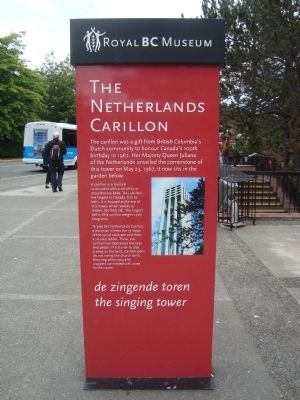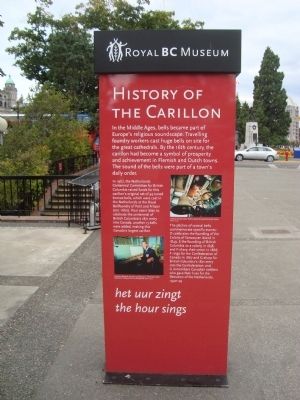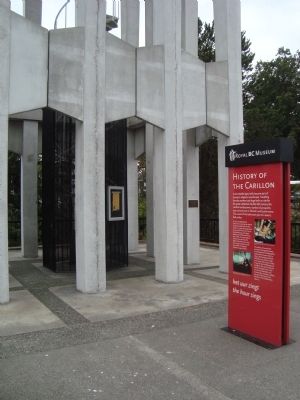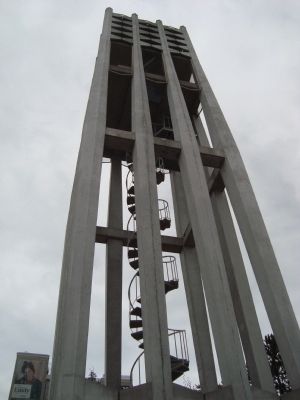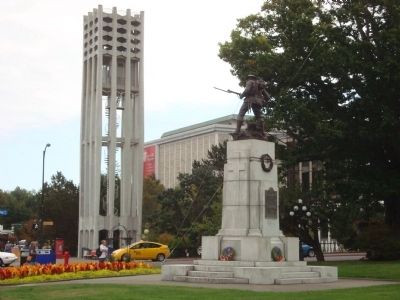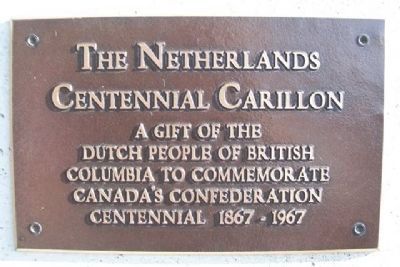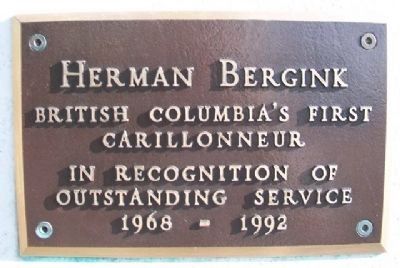The Netherlands Carillon / History of the Carillon
The Netherlands Carillon
The carillon was a gift fro British Columbia’s Dutch community to honour Canada’s 100th birthday in 1967. Her Majesty Queen Juliana of the Netherlands unveiled the cornerstone of this tower on May 23, 1967; it now sits in the garden below.
A carillon is a musical instrument with a set of 23 or more bronze bells. This carillon, the largest in Canada, has 62 bells. It is housed at the top of this tower, which stands 27 meters (89 feet) tall. The largest bell in this carillon weighs 1500 kilograms.
To play the Netherlands Carillon, a musician climbs the 75 steps of the spiral staircase and then a 10-step ladder. There, the carillonneur depresses the keys and pedals of a clavier to play a song on the bells. Carillon bells do not swing like church bells; they ring when struck by clappers connected with wires to the clavier.
de zingende toren
the singing tower
The History of the Carillon
In the Middle Ages, bells became part of Europe’s religious soundscape. Travelling foundry workers cast huge bells on site for great cathedrals. By the 16th century, the carillon had become a symbol of prosperity and achievement in Flemish and Dutch towns. The sound of the bells were part of a town’s daily order.
In 1967, the Netherlands Centennial Committee for British Columbia
raised funds for this carillon’s original set of 49 tuned bronze bells, which were cast in the Netherlands at the Royal Bellfoundry of Petit and Fritsen (est. 1660). Four years later, to celebrate the centennial of British Columbia’s 1871 entry into Canada, and another 13 bells were added, making this Canada’s largest carillon.
The pitches of several bells commemorate specific events: D celebrates the founding of the Colony of Vancouver Island in 1849, E the founding of British Columbia as a colony in 1858, and F-sharp their union in 1866; F rings for the Confederation of Canada in 1867 and G-sharp for British Columbia’s 1871 entry into the Confederation; and G remembers Canadian soldiers who gave their lives for the liberation of the Netherlands, 1940-45.
het uur zingt
the hour sings.
[Photo caption, upper right]
Interior of the tower belfry, above the performance room. RBCM I-05278
[Photo caption, lower left]
Herman Bergink, the first carillonneur. The baton-style keyboard is played with a closed fist. RBCM I-03277
Topics. This historical marker is listed in this topic list: Arts, Letters, Music. A significant historical month for this entry is May 1880.
Location. 48° 25.226′ N, 123° 22.105′ W. Marker is in Victoria, British Columbia, in Capital. It is in James Bay. Marker is at the intersection of Belleville
Other nearby markers. At least 8 other markers are within walking distance of this marker. Emily Carr (within shouting distance of this marker); To Our Glorious Dead (within shouting distance of this marker); Kwakiutl Bear Pole (within shouting distance of this marker); Tsukuba (within shouting distance of this marker); Fort Victoria (within shouting distance of this marker); Helmcken House Historic Site (about 120 meters away, measured in a direct line); The Old Man’s Garden (about 120 meters away); Capt. James Cook, R.N. (about 150 meters away). Touch for a list and map of all markers in Victoria.
Also see . . . Details of the 62-bell carillon. (Submitted on September 4, 2020, by Carl Scott Zimmerman of Kirkwood, Missouri.)
Credits. This page was last revised on February 16, 2023. It was originally submitted on October 29, 2011. This page has been viewed 848 times since then and 28 times this year. Last updated on September 4, 2020, by Carl Scott Zimmerman of Kirkwood, Missouri. Photos: 1, 2, 3, 4, 5. submitted on October 29, 2011, by Barry Swackhamer of Brentwood, California. 6, 7. submitted on June 14, 2014, by William Fischer, Jr. of Scranton, Pennsylvania. • J. Makali Bruton was the editor who published this page.
